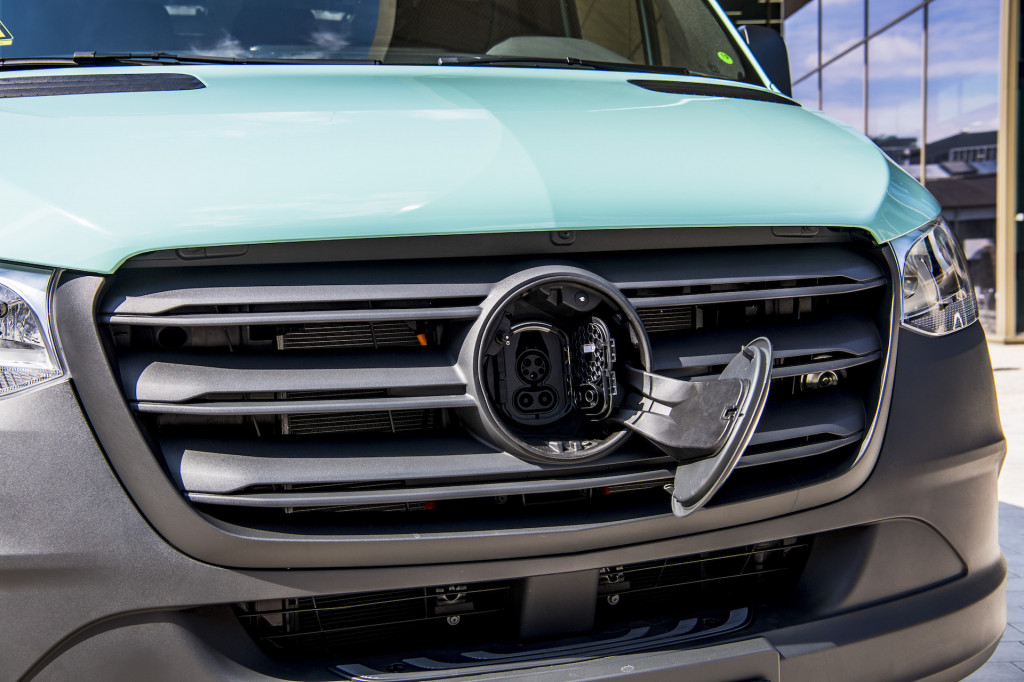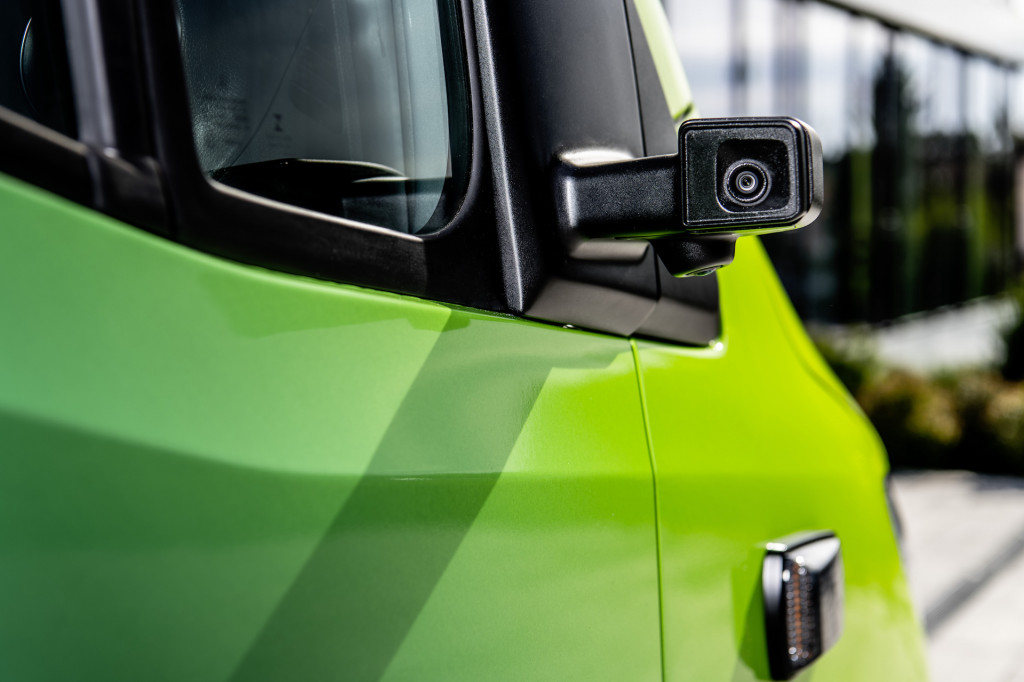Driving a battery-powered commercial panel van may not sound exciting to you—but to Mercedes-Benz and the likes of Amazon and UPS, it promises to be a bellwether moment.
As the Mercedes engineer driving me for a short stint in the prototype eSprinter suggests, there’s very little difference between this box van and the gas- and diesel-powered versions already rolling on U.S. roads. It’s quieter, to be sure, and its direct-drive transmission has zeroed out the lurch and hunt from a conventional transmission.
What’s important is under our feet. The big battery pack that’s been swapped in place of an ICE drivetrain promises cleaner last-mile transportation and simpler service for the companies and municipalities that can begin shifting their vehicle fleets to electric Sprinters as soon as next summer.
By then, Mercedes will have begun production of an upgraded version of its Sprinter vans, and for the first time, that electric version will be assembled and sold in the U.S.
The eSprinter due next year will be an adapted version of the model currently manufactured in a handful of plants and sold in countries that span the globe. It’ll continue to be sold in fossil-fuel models, at least for a while—until a new electric-van architecture arrives mid-decade. That electric commercial vehicle architecture (“Electric Versatility Platform), Benz promises, will eventually replace all ICE-powered vans.
Mercedes-Benz eSprinter preview, April 2022
A two-step electrification process
Production of the U.S.-built electric eSprinter starts next year in Mercedes’ factory outside of Charleston, S.C., according to Mathias Geisen, Head of Mercedes-Benz Vans.
Mercedes has confirmed that the eSprinter will be built not just in Charleston, but also in two plants in Germany. In all plants it will be built alongside the current ICE-powered vans as Mercedes transitions customers to battery power.
While it would not confirm battery pack sizes or suppliers for the new van, only confirming roughly doubled capacity and range, Mercedes has revealed some basics. The future vehicles will be rear-wheel drive with a single electric motor, and powered by a lithium-iron-phosphate (LFP) battery, versus the lithium-ion batteries with nickel-manganese-cobalt (NMC) composition in its EQS and EQE electric cars.

Mercedes-Benz eSprinter preview, April 2022
The LFP packs, Mercedes engineers explained to Green Car Reports, at an event this week in Germany providing some background on upcoming EVs from the company, will deliver more durable lifespans with thousands of additional available charge cycles at a lower cost than NMC packs—a critical consideration for fleet customers that can specify very narrowly how much range and power they need, for how long, and how quickly they must be able to recharge their vehicles. A last-mile parcel-delivery service—say, Amazon—may only need a small pack with limited range, with a charging solution that permits long, low-intensity charging. It could conceivably order a van with more than a ten-year expected duty cycle, with bi-directional charging functionality and with a battery pack which allows a 100% charge without a loss of longevity.
“The good thing about those last-mile deliveries,” Geisen said, “is that they can calculate in detail what they need.” He added, “I think it’s fair to assume that this last-mile delivery industry is basically the industry which will transition to electric, like commercial vehicles, first. Because that’s, from a use case, basically the perfect industry.”
The eSprinter incorporates myriad new pathways for efficiency. Excess motor heat gets led through a heat pump into the HVAC system; an underbody tray smooths airflow beneath the battery pack, which doesn’t raise the ride height versus the ICE-powered Sprinters.

Mercedes-Benz eSprinter preview, April 2022
Charging the last mile
The new van architecture to come mid-decade will greatly expand the company’s ability to deliver a wider range of electric commercial vehicles, above and beyond parcel delivery. Sketches suggest those vehicles will include ambulances, motor homes, and refrigerated vehicles.
“We have been leading in the combustion engine technology, when it comes to vans,” Geisen added. “And we want to keep this technological leadership for those electric vehicles as well.”
But at its core, the market for electric vans centers on parcel delivery, which could fuel an expansion of Sprinter sales in the U.S., Mercedes executives suggest. The company sells the current electric van to Amazon in Europe, but it has waited for its newest version and domestic U.S. production before angling for U.S. fleet customers.
In part, it’s because the battery range of European eSprinters meets the continent’s “last mile” requirements, with its more compact centers of population. For the U.S., “last-mile” range needed for a day’s worth of deliveries could be double that of today’s battery-powered Sprinter—which is precisely what Mercedes suggests its new van will deliver without specifying what those numbers are.
Today’s Euro-market eSprinter comes with a choice of 40-kwh or 50-kwh battery packs.

Mercedes-Benz eSprinter preview, April 2022
By the time the new van architecture arrives, it will permit a range of electric-intensive features that simply aren’t possible on today’s van, including advanced safety features such as automatic emergency braking and blind-spot monitors.
Mercedes demonstrated a new touchscreen infotainment system that will be like that on the EQS and EQE cars, with the ability to predict and plan charging times and cycles; a heated seatbelt and steering wheel, which could obviate the need to leave a vehicle’s heating system on for long periods of time while drivers make deliveries; and an extensive set of cameras including a cargo-bay view, a rear-camera mirror for a full-width view of traffic behind the panel van, bi-panel doors that close automatically, and most interestingly—and not likely for U.S. vehicles, at least at launch—a set of side-view cameras which replace the side mirrors, and display their real-time video in screens set at the top corners of the windshield for a better field of view at pedestrian level.
“We put everything on it,” Geisen said, “because we really believe that for [the] long term, for all use cases, that’s basically the way to go to.”

lasuna order – purchase diarex pills purchase himcolin without prescription
Such a well-structured and engaging article. Thank you!
order generic besivance – purchase besifloxacin generic buy sildamax for sale
neurontin where to buy – sulfasalazine 500mg cost buy sulfasalazine 500 mg generic
celecoxib oral – purchase indomethacin sale generic indocin
colospa 135mg price – order cilostazol 100 mg online cheap pletal 100 mg drug
order rumalaya pills – elavil 50mg oral endep medication
pyridostigmine 60 mg cost – order imitrex 25mg azathioprine 25mg canada
buy voveran tablets – purchase diclofenac sale cheap nimodipine pill
baclofen 25mg ca – ozobax generic feldene 20mg for sale
cyproheptadine 4 mg for sale – buy zanaflex pills order tizanidine 2mg without prescription
buy meloxicam without a prescription – buy generic meloxicam for sale buy toradol without a prescription
artane pills – where can i buy trihexyphenidyl buy emulgel
brand omnicef 300 mg – buy generic clindamycin
accutane sale – buy generic avlosulfon buy deltasone 5mg generic
prednisone 10mg cost – buy generic prednisolone over the counter buy zovirax creams
acticin uk – benzac usa retin drug
buy betnovate cream – monobenzone uk cost benoquin
buy metronidazole medication – buy generic metronidazole online cenforce 50mg without prescription
order generic augmentin 375mg – buy augmentin cheap synthroid
where can i buy clindamycin – indomethacin drug indomethacin 50mg generic
hyzaar where to buy – losartan 25mg cost order keflex online
buy crotamiton for sale – buy aczone gel aczone online
buy modafinil 200mg sale – buy meloset 3 mg without prescription buy meloset 3 mg generic
order zyban pill – buy ayurslim generic buy shuddha guggulu without a prescription
capecitabine sale – buy mefenamic acid tablets danazol 100mg brand
cheap progesterone 200mg – ponstel usa order fertomid
order generic fosamax – order fosamax 70mg sale medroxyprogesterone usa
estrace online order – brand estrace 1mg order arimidex 1mg pills
гѓ—гѓ¬гѓ‰гѓ‹гѓі её‚иІ© гЃЉгЃ™гЃ™г‚Ѓ – гѓ—гѓ¬гѓ‰гѓ‹гѓійЂљиІ©гЃ§иІ·гЃ€гЃѕгЃ™гЃ‹ г‚ёг‚№гѓгѓћгѓѓг‚Ї йЈІгЃїж–№